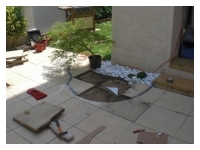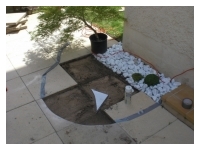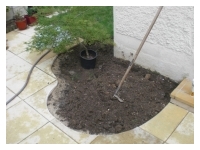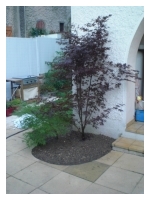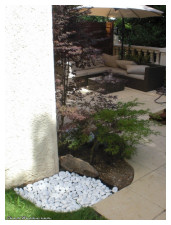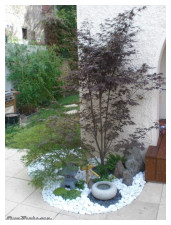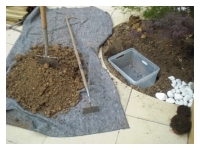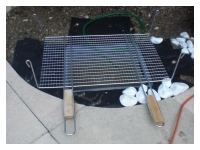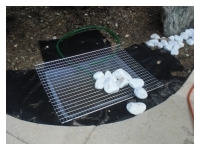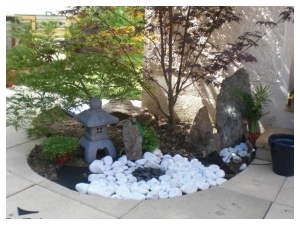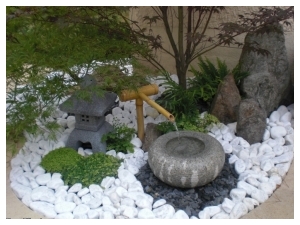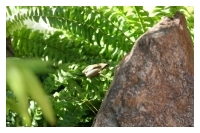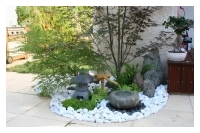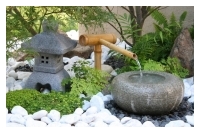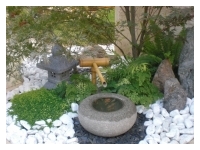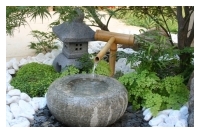Posted on 17/11/2009 at 19:38
Terrace Project : Japanese Garden Tsuboniwa Chaniwa

Tsuboniwa Chaniwa
Since I only had a few square meters, I chose a tsuboniwa-style garden ("courtyard garden") was necessary. These are very small gardens, integrated into closed spaces insides habitations and temples, using the same constitutive elements as their big-brothers : the chaniwa ("tea garden") and the karesensui ("dry garden", usually named "Zen garden" in occident).
This one will be kind of a reduced version of a "tea garden". These gardens are leading to the little house where takes place the ceremony of... tea, you guessed it right.
Here we go! First step, cutting off the concrete tiles to get a nice round shape. It's easier than it looks actually, using an angle grinder with a segmented diamond disc. You just want to go slowly, tracing the cut line on both sides of the tile, then cutting half-way through only (don't try cutting all the way through, you'd block the disc). Then I put the two big trees that will structure the whole set.
The chaniwa gives me the opportunity to integrate Japanese mapple trees, a tree that I really like a lot, which leaves turn bright red at the autumn.
The taller one is anAcer Palmatum Matsumurae while the smaller one is an Acer Palmatum Dissectum (one can recognize it thanks to its dissected leaves). Mapple trees do not like the clay-ish soil of my garden, therefore I gave them a mix of peaty soil, leaf mould and sand, which they seem to appreciate.
Thanks, by the way, to "Blue Toad", my '88 mk.II Rabbit, that has transported absolutely everything possible those past few years...
In the other hand, I did not want the shishi-odoshi made famous by the movie Kill Bill (remember, the fight between Lucy Liù and Uma Thurman in a Japanese garden : that was the bamboo fountain making a regular tocking noise) : too noisy, I only want a tiny whisper of water flow, not giving my neighbors a reason to call the cops... Traditionally, it was supposed to scare away the deers, but well, they are pretty seldom in my neighborhood these days.
A small aquarium pump pushed the water into the bamboo spout, it flows into the sink, overflows into the tank below... Circuit closed.
Next on the list are the plants.
On the ground, some Helexine (creeping plant originating from Corsica, with very small leaves, looks like moss), some Adiantum Fragrans around the tsukubai, and a fern behind the three stones.
These three stones are yet another traditional element of a japanese garden, named sanzoniwagumi, "Buddhist triad stone ", the biggest one representing Buddha.
The naked soil is first covered with geotextile fabric, to avoid unwanted wild grass to grow.
Above, a layer of Carrare white marble pebbles : a bit too shiny at the beginning, but it tend to take a nice patina through time.
At the foot of the maple trees, and of the basin, black slate flakes bring in some contrast. Here is the result in August, i.e. two month after the original setup : all the plants look fine, the Adiantum Fragrans have exploded,the helexine is creeping away covering everything (I'll have to keep an eye on it), the granite basin got some patina.
The lantern is a ceramic model bought in a garden centre ; it's not the cutest ever, but it will do fine until I find a nicer one (not easy in such a small size)...
Same thing for the basin : I originally wanted something more natural (evoking Noguchi's fountain at the NYC Metropolitan museum), that one will stay here until I find the perfect one. Even I'm more than satisfied with the result, it's not really a "Japanese" garden, but more a "Japanese-inspired" one. I've tried as hard as possible to follow the rules and codes of a traditional Japanese garden (whereas adapting it with the local plants and available space), but I'm very far from the look and feel of the masters in that art!
Anyway, I won't stay at that point, a "cloud-shaped" boxtree will come later behind the angle of the building, the whole set up will be harmonized, the rest of the garden will be landscaped as well... To be continued, so.
I've read a lot on the subject before I actually stepped in, studying the different options... If you're interested, I highly recommend the following web sites (all in French, sorry guys, just watch the pictures!) :
- Fuji-Jardins, made by a true enthusiast, it's complete, detailled, pleasant to read, and, last but tnot least, graphically superb.
- Erik Borja's garden is one of the references in this domain, and his website is brilliant.
- Fullhouse-Niwa, a blog following the creation of a Japanese garden, from its "soul-less square of soil" to the final small piece of Japan.
1


